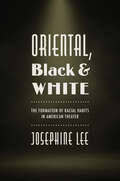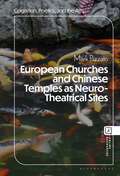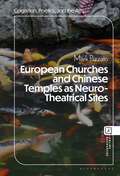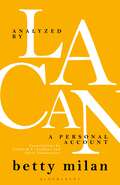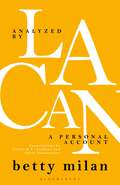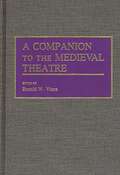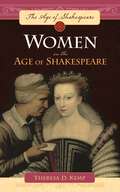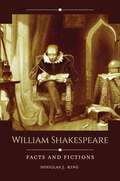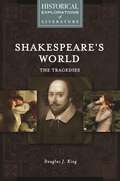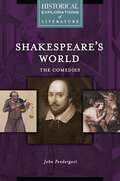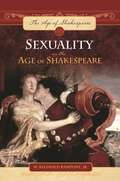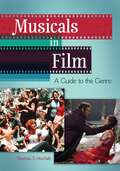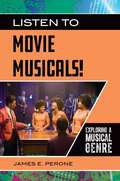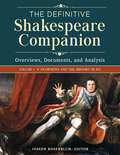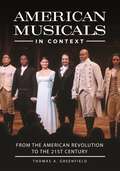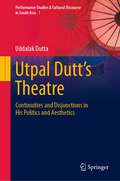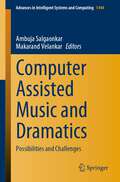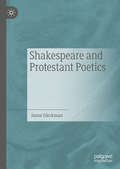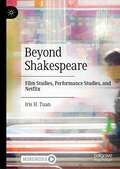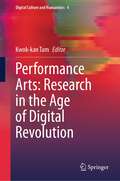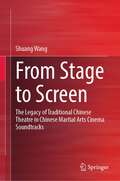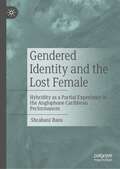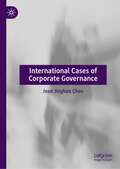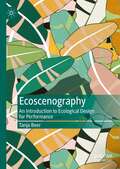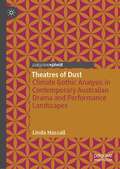- Table View
- List View
Oriental, Black, and White: The Formation of Racial Habits in American Theater
by Josephine LeeIn this book, Josephine Lee looks at the intertwined racial representations of nineteenth- and early twentieth-century American theater. In minstrelsy, melodrama, vaudeville, and musicals, both white and African American performers enacted blackface characterizations alongside oriental stereotypes of opulence and deception, comic servitude, and exotic sexuality. Lee shows how blackface types were often associated with working-class masculinity and the development of a nativist white racial identity for European immigrants, while the oriental marked what was culturally coded as foreign, feminized, and ornamental. These conflicting racial connotations were often intermingled in actual stage performance, as stage productions contrasted nostalgic characterizations of plantation slavery with the figures of the despotic sultan, the seductive dancing girl, and the comic Chinese laundryman. African American performers also performed common oriental themes and characterizations, repurposing them for their own commentary on Black racial progress and aspiration. The juxtaposition of orientalism and black figuration became standard fare for American theatergoers at a historical moment in which the color line was rigidly policed. These interlocking cross-racial impersonations offer fascinating insights into habits of racial representation both inside and outside the theater.
European Churches and Chinese Temples as Neuro-Theatrical Sites (Cognition, Poetics, and the Arts)
by Prof. or Dr. Mark PizzatoCompares monumental designs and performance spaces of Christian, Buddhist, and related sanctuaries, exploring how brain networks, animal-human emotions, and cultural ideals are reflected historically and affected today as "inner theatre" elements. Integrating research across the humanities and sciences, this book explores how traditional designs of outer theatrical spaces left cultural imprints for the inner staging of Self and Other consciousness, which each of us performs daily based on how we think others view us. But believers also perform in a cosmic theatre. Ancestral spirits and gods (or God) watch and interact with them in awe-inspiring spaces, grooming affects toward in-group identification and sacrifice, or out-group rivalry and scapegoating. In a study of over 80 buildings – shown by 40 images in the book, plus thousands of photos and videos online – Pizzato demonstrates how they reflect meta-theatrical projections from prior generations. They also affect the embodied, embedded, enacted, and extended (4E) cognition of current visitors, who bring performance frameworks of belief, hope, and doubt to the sacred site. This involves neuro-social, inner/outer theatre networks with patriarchal, maternal, and trickster paradigms. European Churches and Chinese Temples as Neuro-Theatrical Sites investigates performative material cultures, creating dialogs between theatre, philosophy, history, and various (cognitive, affective, social, biological) sciences. It applies them to the architecture of religious buildings: from Catholic, Orthodox, and Protestant in Europe, plus key sites in Jerusalem and prior “pagan” temples, to Buddhist, Daoist, Confucian, and imperial in China. It thus reveals individualist/collectivist, focal/holistic, analytical/dialectical, and melodramatic/tragicomic trajectories, with cathartic poetics for the future.
European Churches and Chinese Temples as Neuro-Theatrical Sites (Cognition, Poetics, and the Arts)
by Prof. or Dr. Mark PizzatoCompares monumental designs and performance spaces of Christian, Buddhist, and related sanctuaries, exploring how brain networks, animal-human emotions, and cultural ideals are reflected historically and affected today as "inner theatre" elements. Integrating research across the humanities and sciences, this book explores how traditional designs of outer theatrical spaces left cultural imprints for the inner staging of Self and Other consciousness, which each of us performs daily based on how we think others view us. But believers also perform in a cosmic theatre. Ancestral spirits and gods (or God) watch and interact with them in awe-inspiring spaces, grooming affects toward in-group identification and sacrifice, or out-group rivalry and scapegoating. In a study of over 80 buildings – shown by 40 images in the book, plus thousands of photos and videos online – Pizzato demonstrates how they reflect meta-theatrical projections from prior generations. They also affect the embodied, embedded, enacted, and extended (4E) cognition of current visitors, who bring performance frameworks of belief, hope, and doubt to the sacred site. This involves neuro-social, inner/outer theatre networks with patriarchal, maternal, and trickster paradigms. European Churches and Chinese Temples as Neuro-Theatrical Sites investigates performative material cultures, creating dialogs between theatre, philosophy, history, and various (cognitive, affective, social, biological) sciences. It applies them to the architecture of religious buildings: from Catholic, Orthodox, and Protestant in Europe, plus key sites in Jerusalem and prior “pagan” temples, to Buddhist, Daoist, Confucian, and imperial in China. It thus reveals individualist/collectivist, focal/holistic, analytical/dialectical, and melodramatic/tragicomic trajectories, with cathartic poetics for the future.
Analyzed by Lacan: A Personal Account (Psychoanalytic Horizons)
by Dr. Betty MilanAnalyzed by Lacan brings together the first English translations of Why Lacan, Betty Milan's memoir of her analysis with Lacan in the 1970s, and her play, Goodbye Doctor, inspired by her experience. Why Lacan provides a unique and valuable perspective on how Lacan worked as psychoanalyst as well as his approach to psychoanalytic theory. Milan's testimony shows that Lacan's method of working was based on the idea that the traditional way of interpreting provoked resistance. Prior to Why Lacan, Milan wrote a play, Goodbye Doctor, based on her experience as Lacan's patient. The play is structured around the sessions of Seriema with the Doctor. Through the analysis, Seriema discovers why she cannot give birth, namely, an unconscious desire to satisfy the will of her father who didn't authorize her to conceive. She ceases to be the victim of her unconscious, grasps the possibility of choosing a father for her child and thus becoming a mother. Goodbye Doctor has been adapted into a film, Adieu Lacan, by the director Richard Ledes. Analyzed by Lacan features an Introduction by Milan to both works as well as a new interview with Mari Ruti about her writing and Lacan.
Analyzed by Lacan: A Personal Account (Psychoanalytic Horizons)
by Dr. Betty MilanAnalyzed by Lacan brings together the first English translations of Why Lacan, Betty Milan's memoir of her analysis with Lacan in the 1970s, and her play, Goodbye Doctor, inspired by her experience. Why Lacan provides a unique and valuable perspective on how Lacan worked as psychoanalyst as well as his approach to psychoanalytic theory. Milan's testimony shows that Lacan's method of working was based on the idea that the traditional way of interpreting provoked resistance. Prior to Why Lacan, Milan wrote a play, Goodbye Doctor, based on her experience as Lacan's patient. The play is structured around the sessions of Seriema with the Doctor. Through the analysis, Seriema discovers why she cannot give birth, namely, an unconscious desire to satisfy the will of her father who didn't authorize her to conceive. She ceases to be the victim of her unconscious, grasps the possibility of choosing a father for her child and thus becoming a mother. Goodbye Doctor has been adapted into a film, Adieu Lacan, by the director Richard Ledes. Analyzed by Lacan features an Introduction by Milan to both works as well as a new interview with Mari Ruti about her writing and Lacan.
A Companion to the Medieval Theatre
by Ronald W. VinceVince has provided a useful and, for the most part, usable reference work. His introduction should be required reading for anyone approaching medieval theater. ChoiceScholars increasingly see medieval theatre as a complex and vital performance medium related more closely to political, religious, and social life than to literature as we know it. Reflecting the current interest in performance, A Companion to the Medieval Theatre presents 250 alphabetically arranged entries offering a panoramic view of European and British theatrical productions between the years 900 and 1550. The volume features 30 essays contributed by an international group of specialists and includes many shorter entries as well as systematic cross-referencing, a chronology, a bibliography, and a full complement of indexes.Major entries focus on the theatres of the principal linguistic areas (the British Isles, France, Germany, Iberia, Italy, Scandinavia, the Low Countries, and Eastern Europe), and on dramatic forms and genres such as liturgical drama, Passion and saint plays, morality plays, folk drama, and Humanist drama. Other articles examine costume, acting, pageantry, and music, and explore the theatrical dimension of courtly entertainment, the dance, and the tournament. Short entries supply information on over one hundred playwrights, directors, actors and antiquarians whose contributions to the theatre have been documented. This informative guide brings new depth to our appreciation of the richness and color of medieval public entertainments and the symbolism and pageantry that were a part of daily life in the Middle Ages. Designed to appeal to general reader, this volume is also an attractive choice for libraries serving students and scholars of theatre history, English and European literatures, medieval history, cultural history, drama, and performance.
Women in the Age of Shakespeare (The Age of Shakespeare)
by Theresa D. KempThis book offers a look at the lives of Elizabethan era women in the context of the great female characters in the works of William Shakespeare.Like the other entries in this fascinating series, Women in the Age of Shakespeare shows the influence of the world William Shakespeare lived in on the worlds he created for the stage, this time by focusing on women in the Elizabethan and Jacobean eras in general and in Shakespeare's works in particular.Women in the Age of Shakespeare explores the ancient and medieval ideas that Shakespeare drew upon in creating his great comedic and tragic heroines. It then looks at how these ideas intersected with the lived experiences of women of Shakespeare's time, followed by a close look at the major female characters in Shakespeare's plays and poems. Later chapters consider how these characters have been enacted on stage and in film, interpreted by critics and scholars, and re-imagined by writers in our own time.
William Shakespeare: Facts and Fictions (Historical Facts and Fictions)
by Douglas J. KingBased on solid research and clear explanations, this book provides a thorough and up-to-date analysis of 10 key facts and fictions regarding the life and works of William Shakespeare.Shakespeare is perhaps the most famous author in world literature. His works have attracted tremendous critical and historical attention, and the world in which he lived has been the subject of hundreds if not thousands of books. But for all the attention given to Shakespeare and his world, arguments continue about what we can say for sure concerning his life and works. This book brings a unique perspective to the ongoing fascination and debate over the life and works of the most renowned writer of all time.The book focuses on 10 separate key issues, including Shakespeare's sexuality, his religion, his marriage and family, his education, and the vexing "authorship question." Each chapter treats a particular topic and provides a section on what people think happened, how the story developed, and what we now believe is the historical truth. This book looks objectively and closely at evidence to provide the most likely explanations for questions that cannot be definitively answered. Using historical primary source documents, it gives readers the clearest possible view of endlessly fascinating topics.
Shakespeare's World: A Historical Exploration of Literature (Historical Explorations of Literature)
by Douglas J. KingThis analysis of primary documents allows readers to understand Shakespeare's tragedies within the context of historical issues of Renaissance England.Comprising dozens of primary source documents, this book explores Early Modern historical issues reflected in four of Shakespeare's tragedies most commonly taught in secondary schools and universities around the world: Romeo and Juliet, Julius Caesar, Hamlet, and Macbeth.Primary source documents relating to Romeo and Juliet deal with subjects such as dueling, breast-feeding, and the Black Plague. Background discussion of Julius Caesar addresses the influence of Roman culture on Renaissance England; the nature of monarchy; and warfare in Renaissance England, including the defeat of the Spanish Armada. The backdrop for Hamlet includes the nature of spirits; heaven, hell, and purgatory; the history of revenge tragedy beginning with ancient Greece; and debates over the theater in Shakespeare's time. Macbeth brings the reader into the reign of King James and examines ongoing debates over the dangers of witchcraft; the crime of the century, the Gunpowder Plot of 1605; and the "Macbeth curse" that has plagued productions of the Scottish Play since its premiere.
Shakespeare's World: A Historical Exploration of Literature (Historical Explorations of Literature)
by John PendergastWith summaries, discussions, and excerpts from primary source documents, this book examines Shakespeare's world through careful consideration of the historical background of four of his comedies.Comedy was popular during the Renaissance, and it was also one of Shakespeare's specialties. The four plays discussed in this book, A Midsummer Night's Dream, The Merchant of Venice, Twelfth Night and The Tempest, span Shakespeare's career and remind us that Shakespeare, more than any of his contemporaries, explored the possibilities of comedy, consistently developing new approaches to the genre. Shakespeare was a fairly traditional playwright, well aware of the long tradition of comedy, which dates back to the Greeks and Romans. This book places Shakespeare's comedies in their historical context. It includes dedicated chapters on each of the four comedies, with each chapter providing a plot summary, a discussion of the play's historical background and significance, and excerpts from primary source documents related to the play. An introduction surveys the historical background of the plays, while a timeline chronicles key events that influenced them. Suggestions for further reading direct readers to additional sources of information.
Sexuality in the Age of Shakespeare (The Age of Shakespeare)
by W. Reginald Jr.This book examines the important themes of sexuality, gender, love, and marriage in stage, literary, and film treatments of Shakespeare's plays.The theme of sexuality is often integral to Shakespeare's works and therefore merits a thorough exploration.Sexuality in the Age of Shakespeare begins with descriptions of sexuality in ancient Greece and Rome, medieval England, and early-modern Europe and England, then segues into examinations of the role of sexuality in Shakespeare's plays and poetry, and also in film and stage productions of his plays. The author employs various theoretical approaches to establish detailed interpretations of Shakespeare's plays and provides excerpts from several early-modern marriage manuals to illustrate the typical gender roles of the time. The book concludes with bibliographies that students of Shakespeare will find invaluable for further study.
Musicals in Film: A Guide to the Genre
by Thomas S. HischakThis wide-ranging guide introduces (or reintroduces) readers to movie musicals past and present, enabling them to experience the development of this uniquely American art form—and discover films they'll love.This comprehensive guide covers movie musicals from their introduction with the 1927 film The Jazz Singer through 2015 releases. In all, it describes 125 movies, opening up the world of this popular form of entertainment to preteens, teens, and adults alike.An introduction explains the advent of movie musicals; then, in keeping with the book's historical approach, films are presented by decade and year with overviews of advances during particular periods. In this way, the reader not only learns about individual films but can see the big picture of how movie musicals developed and changed over time. For each film covered, the guide offers basic facts—studio, director, songwriters, actors, etc.—as well as a brief plot synopsis. Each entry also offers an explanation of why the movie is noteworthy, how popular it was or wasn't, and the influence the film might have had on later musicals. Sidebars offering brief biographies of important artists appear throughout the book.
Listen to Movie Musicals!: Exploring a Musical Genre (Exploring Musical Genres)
by James E. PeroneListen to Movie Musicals! provides an overview of musical theater on film for fans of the genre, with a focus on 50 must-hear musicals featured in movies.Listen to Movie Musicals! includes an overview of musical theatre and movie musicals in the United States. The 50 movies chosen for critical analysis include many of the best-known film musicals of the past and present; however, the list also includes several important movie musicals that were popular successes that are not necessarily on the "best-of" lists in other books. This volume also includes a greater focus on the actual music of movie musicals than do most other books, making it a stand-out title on the topic for high school and college readers. Like the other books in this series, this volume includes a background chapter followed by a chapter that contains 50 important essays on must-hear movie musicals of approximately 1,500 words each. Chapters on the impact of movie musicals on popular culture and the legacy of movie musicals further explain the impact of both the movies and their songs.
The Definitive Shakespeare Companion [4 volumes]: Overviews, Documents, and Analysis [4 volumes]
by Editor Joseph RosenblumThis expansive four-volume work gives students detailed explanations of Shakespeare's plays and poems and also covers his age, life, theater, texts, and language. Numerous excerpts from primary source historical documents contextualize his works, while reviews of productions chronicle his performance history and reception.Shakespeare's works often served to convey simple truths, but they are also complex, multilayered masterpieces. Shakespeare drew on varied sources to create his plays, and while the plays are sometimes set in worlds before the Elizabethan age, they nonetheless parallel and comment on situations in his own era. Written with the needs of students in mind, this four-volume set demystifies Shakespeare for today's readers and provides the necessary perspective and analysis students need to better appreciate the genius of his work. This indispensable ready reference examines Shakespeare's plots, language, and themes; his use of sources and exploration of issues important to his age; the interpretation of his works through productions from the Renaissance to the present; and the critical reaction to key questions concerning his writings. The book provides coverage of each key play and poems in discrete sections, with each section presenting summaries; discussions of themes, characters, language, and imagery; and clear explications of key passages. Readers will be able to inspect historical documents related to the topics explored in the work being discussed and view excerpts from Shakespeare's sources as well as reviews of major productions. The work also provides a comprehensive list of print and electronic resources suitable for student research.
American Musicals in Context: From the American Revolution to the 21st Century
by Thomas A. GreenfieldAmerican Musicals in Context: From the American Revolution to the 21st Century gives students a fresh look at history-based musicals, helping readers to understand the American story through one of the country's most celebrated art forms: the musical.With the hit musical Hamilton (2015) captivating audiences and reshaping the way early U.S. history is taught and written about, this book offers insight into an array of musicals that explore U.S. history. The work provides a synopsis, overview of critical and audience reception, and historical context and analysis for each of 20 musicals selected for the unique and illuminating way they present the American story on the stage.Specifically, this volume explores musicals that have centered their themes, characters, and plots on some aspect of America's complex and ever-changing history. Each in its own way helps us rediscover pivotal national crises, key political decisions, defining moral choices, unspeakable and unresolved injustices, important and untold stories, defeats suffered, victories won in the face of monumental adversity, and the sacrifices borne publicly and privately in the process of creating the American narrative, one story at a time. Students will come away from the volume armed with the critical thinking skills necessary to discern fact from fiction in U.S. history.
Utpal Dutt's Theatre: Continuities and Disjunctions in His Politics and Aesthetics (Performance Studies & Cultural Discourse in South Asia #1)
by Uddalak DuttaThis book offers the reader an in-depth understanding of Utpal Dutt’s entire career in drama. Covering Dutt’s career in proscenium, street theatre and Jatra, it analyzes the interesting exchange of dramatic art with politics in his theatre. Owing to a plethora of unsubstantiated opinions, Dutt is either revered by his followers or dismissed by his opponents, but hardly ever studied with necessary objectivity and intellectual rigour. The book attempts to bust the myth that Dutt was primarily a political propagandist who used theatre only as a means to achieve his political end. The remarkable range of Dutt’s subject matter makes him as internationally significant as he is loved by Indian theatre enthusiasts. His work has been discussed on various reputed international platforms. Yet there is a stark lacuna when it comes to intellectual attention devoted to Dutt’s theatre. This is the first book which attempts to introduce Dutt’s theatre comprehensively to an international readership. The book looks briefly at Dutt’s life, the impact of his politics on his theatre, the art of his characterization, his dramaturgy and stage technique, and the legacy of his work in theatre. It also offers the reader with a chronological list of the first performances of his original theatrical works and an exhaustive bibliography, which, it is hoped, shall prove especially useful for researchers. The book is designed for lay theatre enthusiasts as well as advanced students of theatre.
Computer Assisted Music and Dramatics: Possibilities and Challenges (Advances in Intelligent Systems and Computing #1444)
by Ambuja Salgaonkar Makarand VelankarThis book is intended for researchers interested in using computational methods and tools to engage with music, dance and theatre. The chapters have evolved out of presentations and deliberations at an international workshop entitled Computer Assisted Music and Dramatics: Possibilities and Challenges organized by University of Mumbai in honour of Professor Hari Sahasrabuddhe, a renowned educator and a pioneering computational musicologist (CM) of Indian classical music. The workshop included contributions from CM as well as musicians with a special focus on South Asian arts. The case studies and reflective essays here are based on analyses of genres, practices and theoretical constructs modelled computationally. They offer a balanced and complementary perspective to help innovation in the synthesis of music by extracting information from recorded performances. This material would be of interest to scholars of the sciences and humanities and facilitate exchanges and generation of ideas.
Shakespeare and Protestant Poetics
by Jason GleckmanThis book explores the impact of the sixteenth-century Reformation on the plays of William Shakespeare. Taking three fundamental Protestant concerns of the era – (double) predestination, conversion, and free will – it demonstrates how Protestant theologians, in England and elsewhere, re-imagined these longstanding Christian concepts from a specifically Protestant perspective. Shakespeare utilizes these insights to generate his distinctive view of human nature and the relationship between humans and God. Through in-depth readings of the Shakespeare comedies ‘The Merry Wives of Windsor’, ‘Much Ado About Nothing’, ‘A Midsummer Night’s Dream’, and ‘Twelfth Night’, the romance ‘A Winter’s Tale’, and the tragedies of ‘Macbeth’ and ‘Hamlet’, this book examines the results of almost a century of Protestant thought upon literary art.
Beyond Shakespeare: Film Studies, Performance Studies, and Netflix
by Iris H. TuanWith joy and grace to accompany the readers to have the translocal tour to visit about thirty-seven works, this monograph applies the academic critical theories of Performance Studies, Film Studies, Psychoanalysis, Postmodernism, and Visual Culture, to interpreting the special selection works. The focus and common theme are on race, body, and class. With the background of COVID-19 since 2019 up to the present, the book offers the readers with the remarkable insight of human beings’ accumulated wisdom and experiences in surviving with the dreadful diseases like the plagues in Shakespeare’s time. After the supreme reading, may the global readers in the world acquire the knowledge and power to live in sustainability with education and entertainment of films, performances, and online streaming Netflix TV dramas.
Performance Arts: Research in the Age of Digital Revolution (Digital Culture and Humanities #4)
by Kwok-Kan TamThis volume reshapes a contemporary understanding of research in theatre and performance arts. Bringing together distinguished scholars from all over the world, the book serves as an arena for international scholars to introduce innovative research methodologies and disseminate their research findings regarding VLT, data archiving, and digital history and discusses the impacts of digital culture in art production, stage performance, film, and literature. The Ibsen focus in the book is illustrative of the power of digital database research that is generating new relations in spatial-historical dimensions that have otherwise gone unnoticed. It demonstrates how a new methodology can bring practical benefits to handling big data with the support of digital technologies. In line with the post-pandemic landscape, this book engages a reflection on how the digital revolution has brought about changes and challenges, and constraints and breakthroughs within the field of theatre and performance arts. It is of appeal to theatre artists and practitioners, scholars, critics, librarians, digital archive engineers, and postgraduate students interested in theatre, performance studies, digital media, information technology, library science, communication, education, sociology, as well as political science. “The book investigates the latest methodological development in digital cultures and performance arts, which significantly contributes to the ever-changing and increasingly advanced technological culture in this field.” - Jessica Tsui-yan Li, York University, Canada"In line with the post-pandemic landscape, this book engages the reader in reflecting on how the digital revolution has brought about chances and challenges, constraints and breakthroughs to the field of theatre and performance arts. An original, eye-opening and inspiring volume at multiple levels, this book brings together distinguished scholars from all over the world." - Dr Anna Tso, The Hang Seng University of Hong Kong
From Stage to Screen: The Legacy of Traditional Chinese Theatre in Chinese Martial Arts Cinema Soundtracks
by Shuang WangChinese martial arts cinema is held to be a synthesis drawing on artistic conventions of traditional Chinese theatre. Film sound and music perform as the legitimate heirs of some of the aesthetic ideas and norms of traditional Chinese theatre. This book critically examines the history of this under-explored field of inquiry from a theoretically comparative perspective, demonstrating that the musical codes drawn from traditional theatre are a constantly changing component integral to Chinese martial arts cinema. It explores the interaction between traditional Chinese theatre and Chinese martial arts cinema in how the musical codes of the former have shaped the aesthetics of the latter uniquely. This departs from conventional existing studies that focus on “adaptation.” The book’s historical and theoretical approach connects film, theatre and music, and re-defines the status of distinctive domains of filmic expression, grounding theatre as the pivot – or “hinge” – of film aesthetics. The book proffers this unique angle of research to rethink and re-imagine film sound and audiovisual synchronisation. Primarily intended for scholars in Chinese cinema, film music, Chinese theatre and visual culture, this monograph also presents introductory and comprehensive material for undergraduate and graduate-level courses in film and media studies, film music, Chinese cinema, and Chinese theatre.
Gendered Identity and the Lost Female: Hybridity as a Partial Experience in the Anglophone Caribbean Performances
by Shrabani BasuThis book offers an exploration of the postcolonial hybrid experience in anglophone Caribbean plays and performance from a feminist perspective.In a hitherto unattempted consideration of Caribbean theatre and performance, this study of gendered identities chronicles the postcolonial hybrid experience – and how it varies in the context of questions of sex, performance and social designation. In the process, it examines the diverse performances of the anglophone Caribbean. The work includes works by Caribbean anglophone playwrights like Derek Walcott, Mustapha Matura, Michael Gikes, Dennis Scott, Trevor Rhone, Earl Lovelace and Errol John with more recent works of Pat Cumper, Rawle Gibbons and Tony Hall. The study would also engage with Carnival, calypso and chutney music, while commenting on its evolving influences over the hybrid imagination.Each section covers the dominant socio-political thematics associated with the tradition and its effect on it, followed by an analysis of contemporaneously significant literary and cultural works – plays, carnival narrative and calypso and chutney lyrics as well as the experiences of performers. From Lovelace’s fictional Jestina to the real-life Drupatee, the book critically explores the marginalization of female performances while forming a hybrid identity.
International Cases of Corporate Governance
by Jean Jinghan ChenThis book provides insights into current issues in corporate governance by examining twelve cases from the 2010s and 2020s where corporate governance was seen to be an issue. The cases are designed to introduce the reader to ‘real life’ episodes with corporate governance implications, shedding light on why corporate scandals continue to occuer, to what extent these are a corporate governance failure, and in which ways corporate governance – and the behaviour of those involved in ensuring good governance and an ethical culture in their business - may be improved in the future. This book will be of interest to businesspeople, students of business, and lawyers and motivate discussion on the reasons why corporate governance failed, or was seen to be inadequate.
Ecoscenography: An Introduction to Ecological Design for Performance
by Tanja BeerThis ground-breaking book is the first to bring an ecological focus to theatre and performance design, both in scholarship and in practice. Ecoscenography weaves environmental philosophies and practices across genres and fields to provide a captivating vision for the future of sustainable theatre production. The book forefronts leading designers that are driving this emerging field into the mainstream through their relational and reciprocal engagement with place, audiences, materials, and processes. Beyond its radical philosophy and framework, Ecoscenography makes a compelling case for pursuing an ecological ethic in theatre and performance design, not only as a moral imperative, but for the extraordinary possibilities that it offers for more-than-human engagement. Based on her personal insights as a leading ecological researcher and practitioner, Beer offers a rich resource for scholars, students and practitioners alike, opening up new processes and aesthetics of theatrical design that enhance the environmental and social advocacy of the field.
Theatres of Dust: Climate Gothic Analysis in Contemporary Australian Drama and Performance Landscapes
by Linda HassallThrough a contemporary Gothic lens, the book explores theatre theories, processes and practices that explore; the impacts of continuing drought and natural disaster, the conflicts concerning resource extraction and mining and current political debates focussed on climate change denial. While these issues can be argued from various political and economic platforms, theatrical investigations as discussed here suggest that scholars and theatre makers are becoming empowered to dramaturgically explore the ecological challenges we face now and may face in the future. In doing so the book proposes that theatre can engage in not only climate change analysis and discussion but can develop climate literacies in a broader socio-cultural context.
